Cultural Intelligence in Companies
VerifiedAdded on 2023/06/14
|8
|1854
|440
AI Summary
This article discusses the importance of cultural intelligence in companies and how it affects management of employees and customers in Asia. It also covers the concept of creating shared value and its impact on businesses. The article provides examples of companies that have successfully implemented cultural intelligence and creating shared value in their operations.
Contribute Materials
Your contribution can guide someone’s learning journey. Share your
documents today.
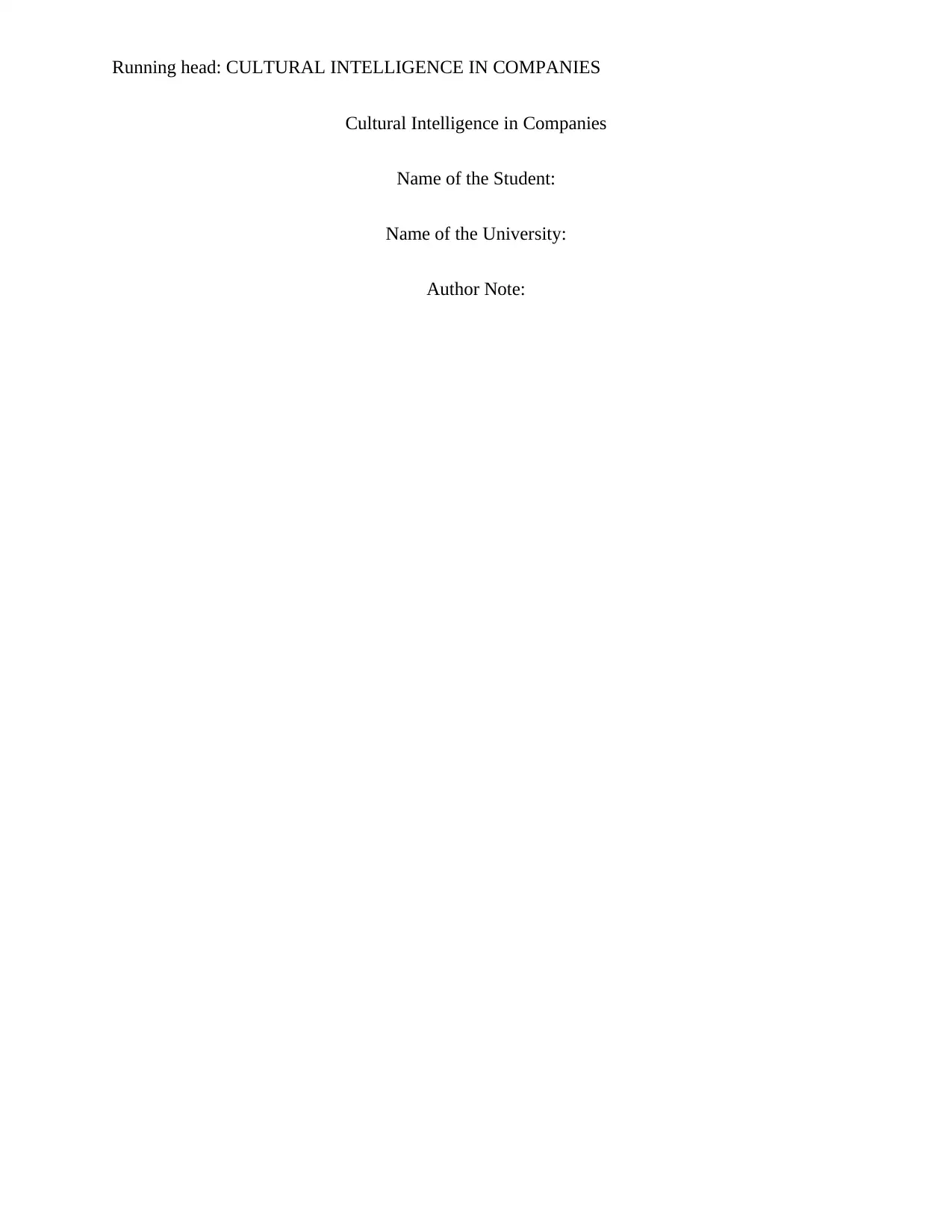
Running head: CULTURAL INTELLIGENCE IN COMPANIES
Cultural Intelligence in Companies
Name of the Student:
Name of the University:
Author Note:
Cultural Intelligence in Companies
Name of the Student:
Name of the University:
Author Note:
Secure Best Marks with AI Grader
Need help grading? Try our AI Grader for instant feedback on your assignments.
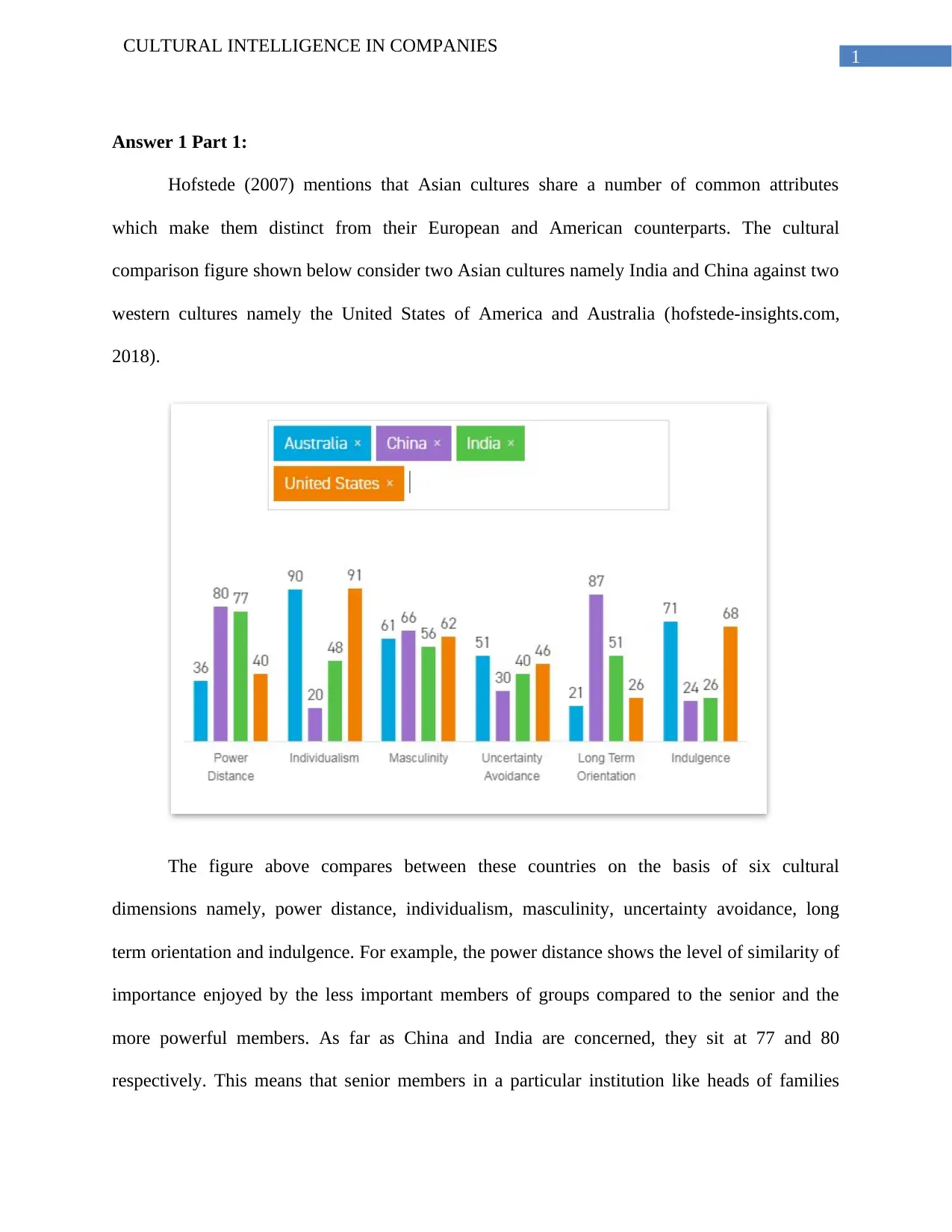
1
CULTURAL INTELLIGENCE IN COMPANIES
Answer 1 Part 1:
Hofstede (2007) mentions that Asian cultures share a number of common attributes
which make them distinct from their European and American counterparts. The cultural
comparison figure shown below consider two Asian cultures namely India and China against two
western cultures namely the United States of America and Australia (hofstede-insights.com,
2018).
The figure above compares between these countries on the basis of six cultural
dimensions namely, power distance, individualism, masculinity, uncertainty avoidance, long
term orientation and indulgence. For example, the power distance shows the level of similarity of
importance enjoyed by the less important members of groups compared to the senior and the
more powerful members. As far as China and India are concerned, they sit at 77 and 80
respectively. This means that senior members in a particular institution like heads of families
CULTURAL INTELLIGENCE IN COMPANIES
Answer 1 Part 1:
Hofstede (2007) mentions that Asian cultures share a number of common attributes
which make them distinct from their European and American counterparts. The cultural
comparison figure shown below consider two Asian cultures namely India and China against two
western cultures namely the United States of America and Australia (hofstede-insights.com,
2018).
The figure above compares between these countries on the basis of six cultural
dimensions namely, power distance, individualism, masculinity, uncertainty avoidance, long
term orientation and indulgence. For example, the power distance shows the level of similarity of
importance enjoyed by the less important members of groups compared to the senior and the
more powerful members. As far as China and India are concerned, they sit at 77 and 80
respectively. This means that senior members in a particular institution like heads of families
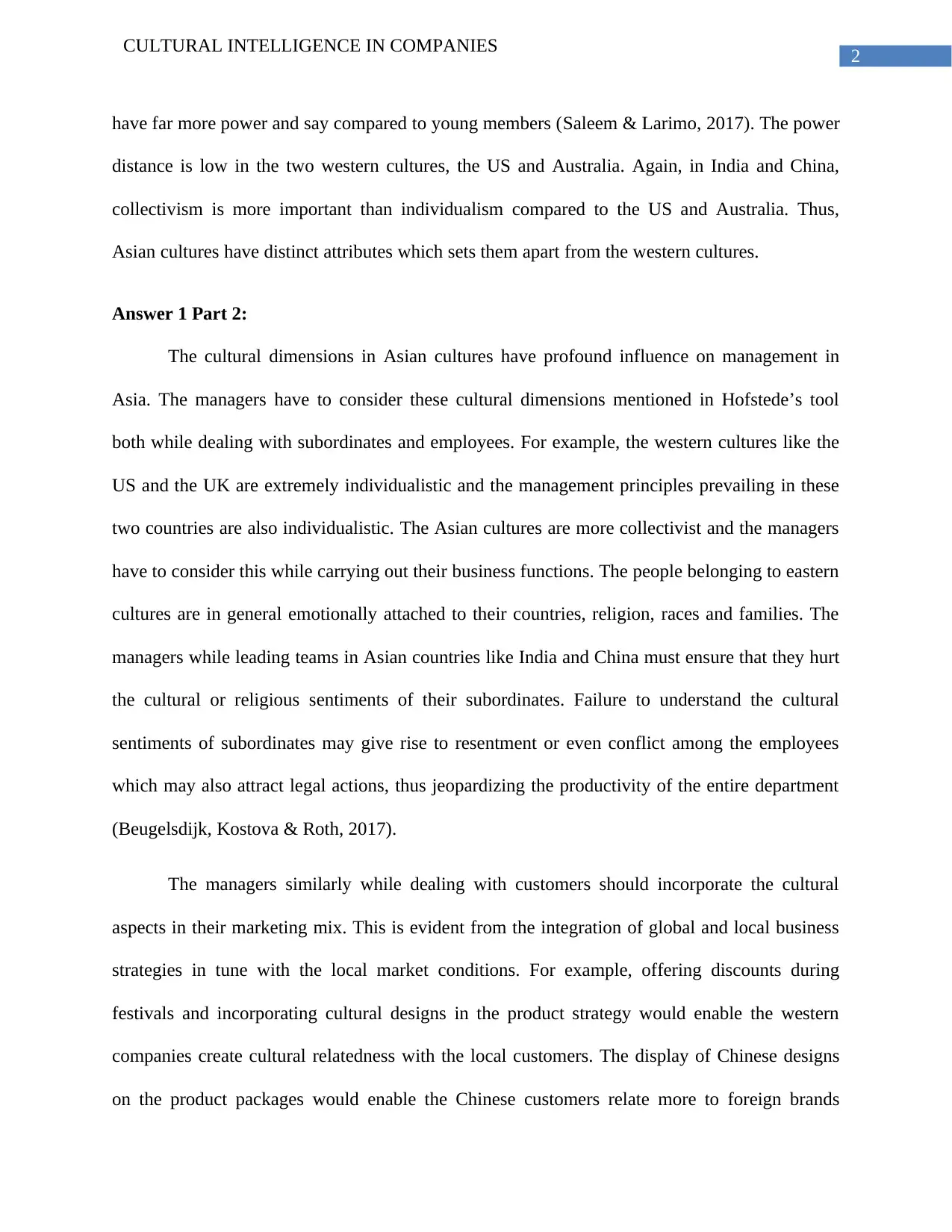
2
CULTURAL INTELLIGENCE IN COMPANIES
have far more power and say compared to young members (Saleem & Larimo, 2017). The power
distance is low in the two western cultures, the US and Australia. Again, in India and China,
collectivism is more important than individualism compared to the US and Australia. Thus,
Asian cultures have distinct attributes which sets them apart from the western cultures.
Answer 1 Part 2:
The cultural dimensions in Asian cultures have profound influence on management in
Asia. The managers have to consider these cultural dimensions mentioned in Hofstede’s tool
both while dealing with subordinates and employees. For example, the western cultures like the
US and the UK are extremely individualistic and the management principles prevailing in these
two countries are also individualistic. The Asian cultures are more collectivist and the managers
have to consider this while carrying out their business functions. The people belonging to eastern
cultures are in general emotionally attached to their countries, religion, races and families. The
managers while leading teams in Asian countries like India and China must ensure that they hurt
the cultural or religious sentiments of their subordinates. Failure to understand the cultural
sentiments of subordinates may give rise to resentment or even conflict among the employees
which may also attract legal actions, thus jeopardizing the productivity of the entire department
(Beugelsdijk, Kostova & Roth, 2017).
The managers similarly while dealing with customers should incorporate the cultural
aspects in their marketing mix. This is evident from the integration of global and local business
strategies in tune with the local market conditions. For example, offering discounts during
festivals and incorporating cultural designs in the product strategy would enable the western
companies create cultural relatedness with the local customers. The display of Chinese designs
on the product packages would enable the Chinese customers relate more to foreign brands
CULTURAL INTELLIGENCE IN COMPANIES
have far more power and say compared to young members (Saleem & Larimo, 2017). The power
distance is low in the two western cultures, the US and Australia. Again, in India and China,
collectivism is more important than individualism compared to the US and Australia. Thus,
Asian cultures have distinct attributes which sets them apart from the western cultures.
Answer 1 Part 2:
The cultural dimensions in Asian cultures have profound influence on management in
Asia. The managers have to consider these cultural dimensions mentioned in Hofstede’s tool
both while dealing with subordinates and employees. For example, the western cultures like the
US and the UK are extremely individualistic and the management principles prevailing in these
two countries are also individualistic. The Asian cultures are more collectivist and the managers
have to consider this while carrying out their business functions. The people belonging to eastern
cultures are in general emotionally attached to their countries, religion, races and families. The
managers while leading teams in Asian countries like India and China must ensure that they hurt
the cultural or religious sentiments of their subordinates. Failure to understand the cultural
sentiments of subordinates may give rise to resentment or even conflict among the employees
which may also attract legal actions, thus jeopardizing the productivity of the entire department
(Beugelsdijk, Kostova & Roth, 2017).
The managers similarly while dealing with customers should incorporate the cultural
aspects in their marketing mix. This is evident from the integration of global and local business
strategies in tune with the local market conditions. For example, offering discounts during
festivals and incorporating cultural designs in the product strategy would enable the western
companies create cultural relatedness with the local customers. The display of Chinese designs
on the product packages would enable the Chinese customers relate more to foreign brands
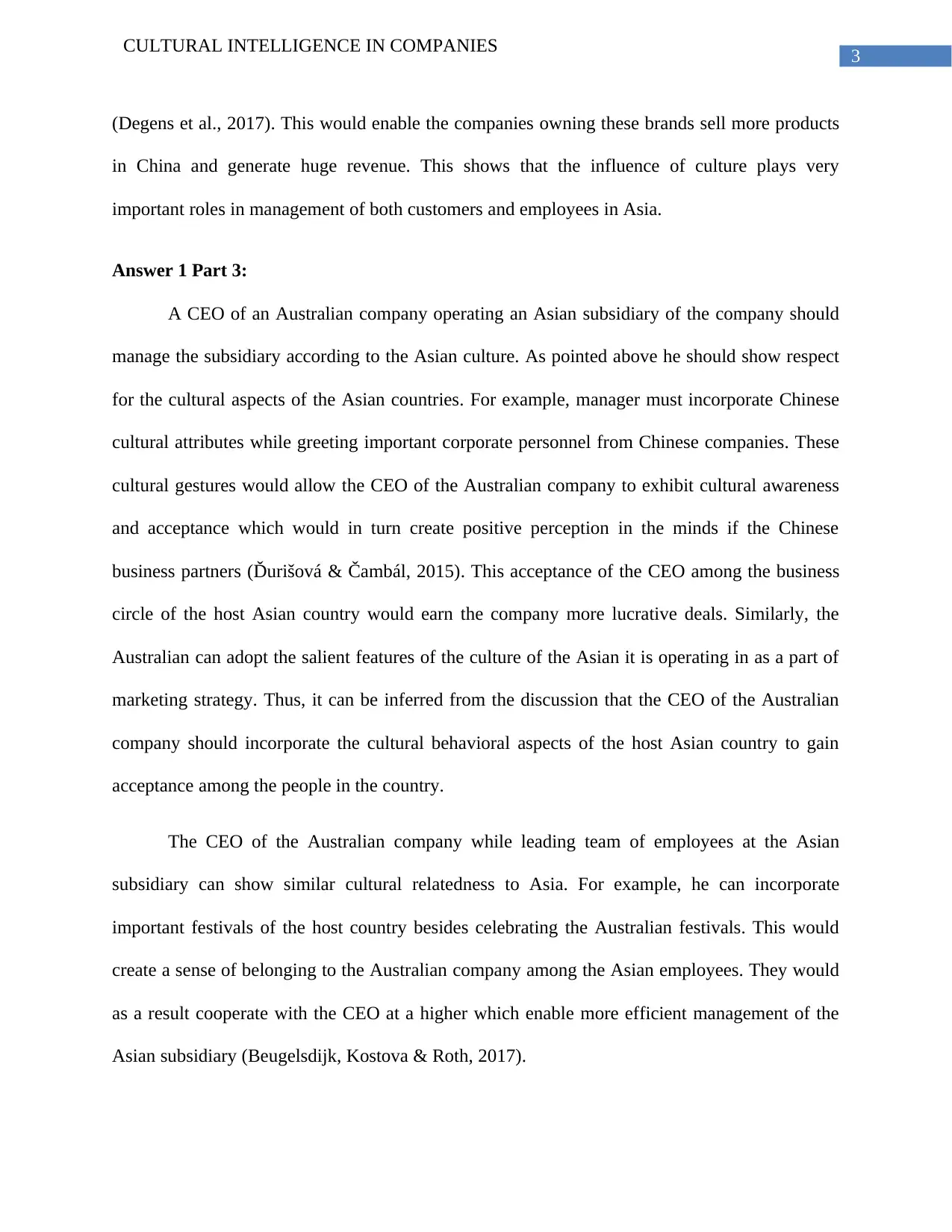
3
CULTURAL INTELLIGENCE IN COMPANIES
(Degens et al., 2017). This would enable the companies owning these brands sell more products
in China and generate huge revenue. This shows that the influence of culture plays very
important roles in management of both customers and employees in Asia.
Answer 1 Part 3:
A CEO of an Australian company operating an Asian subsidiary of the company should
manage the subsidiary according to the Asian culture. As pointed above he should show respect
for the cultural aspects of the Asian countries. For example, manager must incorporate Chinese
cultural attributes while greeting important corporate personnel from Chinese companies. These
cultural gestures would allow the CEO of the Australian company to exhibit cultural awareness
and acceptance which would in turn create positive perception in the minds if the Chinese
business partners (Ďurišová & Čambál, 2015). This acceptance of the CEO among the business
circle of the host Asian country would earn the company more lucrative deals. Similarly, the
Australian can adopt the salient features of the culture of the Asian it is operating in as a part of
marketing strategy. Thus, it can be inferred from the discussion that the CEO of the Australian
company should incorporate the cultural behavioral aspects of the host Asian country to gain
acceptance among the people in the country.
The CEO of the Australian company while leading team of employees at the Asian
subsidiary can show similar cultural relatedness to Asia. For example, he can incorporate
important festivals of the host country besides celebrating the Australian festivals. This would
create a sense of belonging to the Australian company among the Asian employees. They would
as a result cooperate with the CEO at a higher which enable more efficient management of the
Asian subsidiary (Beugelsdijk, Kostova & Roth, 2017).
CULTURAL INTELLIGENCE IN COMPANIES
(Degens et al., 2017). This would enable the companies owning these brands sell more products
in China and generate huge revenue. This shows that the influence of culture plays very
important roles in management of both customers and employees in Asia.
Answer 1 Part 3:
A CEO of an Australian company operating an Asian subsidiary of the company should
manage the subsidiary according to the Asian culture. As pointed above he should show respect
for the cultural aspects of the Asian countries. For example, manager must incorporate Chinese
cultural attributes while greeting important corporate personnel from Chinese companies. These
cultural gestures would allow the CEO of the Australian company to exhibit cultural awareness
and acceptance which would in turn create positive perception in the minds if the Chinese
business partners (Ďurišová & Čambál, 2015). This acceptance of the CEO among the business
circle of the host Asian country would earn the company more lucrative deals. Similarly, the
Australian can adopt the salient features of the culture of the Asian it is operating in as a part of
marketing strategy. Thus, it can be inferred from the discussion that the CEO of the Australian
company should incorporate the cultural behavioral aspects of the host Asian country to gain
acceptance among the people in the country.
The CEO of the Australian company while leading team of employees at the Asian
subsidiary can show similar cultural relatedness to Asia. For example, he can incorporate
important festivals of the host country besides celebrating the Australian festivals. This would
create a sense of belonging to the Australian company among the Asian employees. They would
as a result cooperate with the CEO at a higher which enable more efficient management of the
Asian subsidiary (Beugelsdijk, Kostova & Roth, 2017).
Secure Best Marks with AI Grader
Need help grading? Try our AI Grader for instant feedback on your assignments.
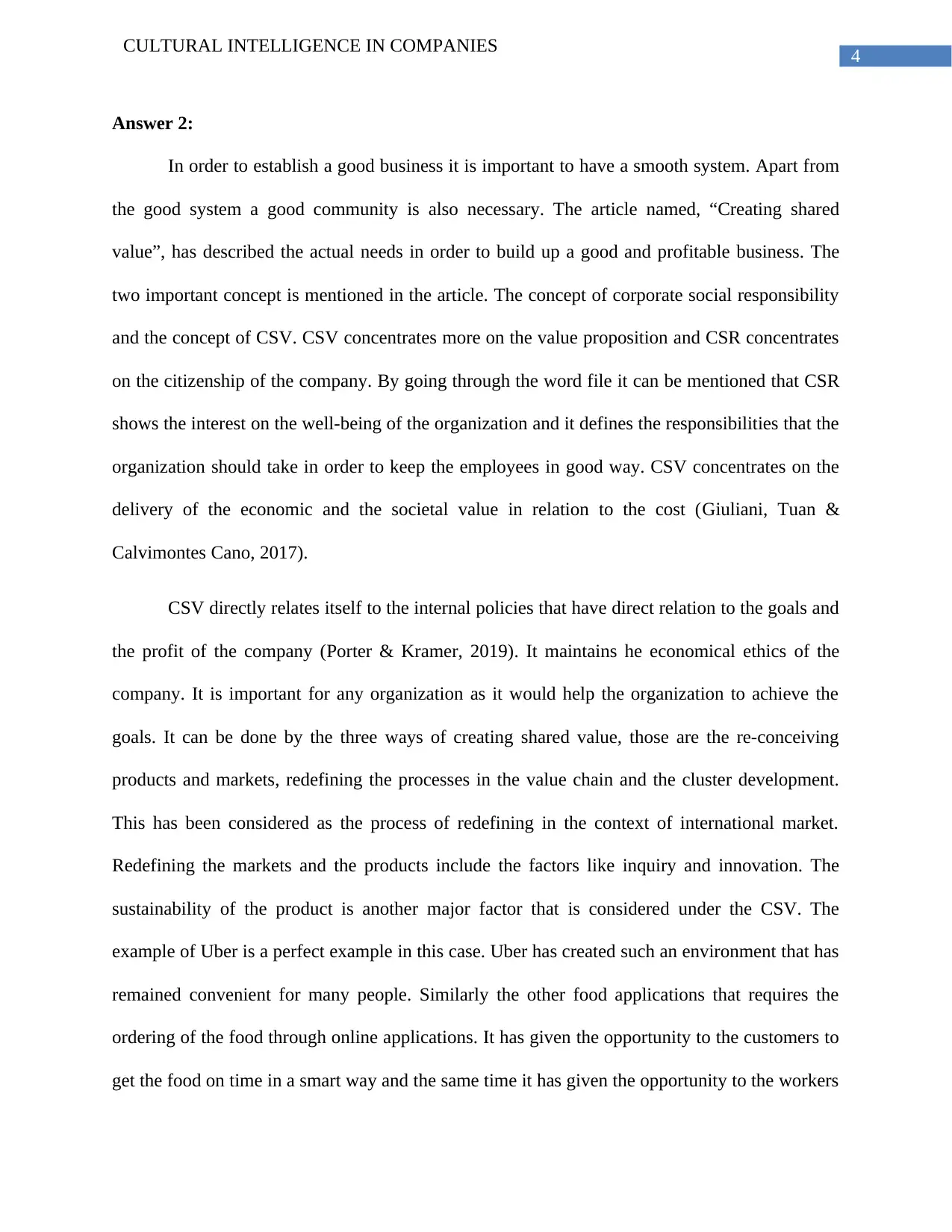
4
CULTURAL INTELLIGENCE IN COMPANIES
Answer 2:
In order to establish a good business it is important to have a smooth system. Apart from
the good system a good community is also necessary. The article named, “Creating shared
value”, has described the actual needs in order to build up a good and profitable business. The
two important concept is mentioned in the article. The concept of corporate social responsibility
and the concept of CSV. CSV concentrates more on the value proposition and CSR concentrates
on the citizenship of the company. By going through the word file it can be mentioned that CSR
shows the interest on the well-being of the organization and it defines the responsibilities that the
organization should take in order to keep the employees in good way. CSV concentrates on the
delivery of the economic and the societal value in relation to the cost (Giuliani, Tuan &
Calvimontes Cano, 2017).
CSV directly relates itself to the internal policies that have direct relation to the goals and
the profit of the company (Porter & Kramer, 2019). It maintains he economical ethics of the
company. It is important for any organization as it would help the organization to achieve the
goals. It can be done by the three ways of creating shared value, those are the re-conceiving
products and markets, redefining the processes in the value chain and the cluster development.
This has been considered as the process of redefining in the context of international market.
Redefining the markets and the products include the factors like inquiry and innovation. The
sustainability of the product is another major factor that is considered under the CSV. The
example of Uber is a perfect example in this case. Uber has created such an environment that has
remained convenient for many people. Similarly the other food applications that requires the
ordering of the food through online applications. It has given the opportunity to the customers to
get the food on time in a smart way and the same time it has given the opportunity to the workers
CULTURAL INTELLIGENCE IN COMPANIES
Answer 2:
In order to establish a good business it is important to have a smooth system. Apart from
the good system a good community is also necessary. The article named, “Creating shared
value”, has described the actual needs in order to build up a good and profitable business. The
two important concept is mentioned in the article. The concept of corporate social responsibility
and the concept of CSV. CSV concentrates more on the value proposition and CSR concentrates
on the citizenship of the company. By going through the word file it can be mentioned that CSR
shows the interest on the well-being of the organization and it defines the responsibilities that the
organization should take in order to keep the employees in good way. CSV concentrates on the
delivery of the economic and the societal value in relation to the cost (Giuliani, Tuan &
Calvimontes Cano, 2017).
CSV directly relates itself to the internal policies that have direct relation to the goals and
the profit of the company (Porter & Kramer, 2019). It maintains he economical ethics of the
company. It is important for any organization as it would help the organization to achieve the
goals. It can be done by the three ways of creating shared value, those are the re-conceiving
products and markets, redefining the processes in the value chain and the cluster development.
This has been considered as the process of redefining in the context of international market.
Redefining the markets and the products include the factors like inquiry and innovation. The
sustainability of the product is another major factor that is considered under the CSV. The
example of Uber is a perfect example in this case. Uber has created such an environment that has
remained convenient for many people. Similarly the other food applications that requires the
ordering of the food through online applications. It has given the opportunity to the customers to
get the food on time in a smart way and the same time it has given the opportunity to the workers
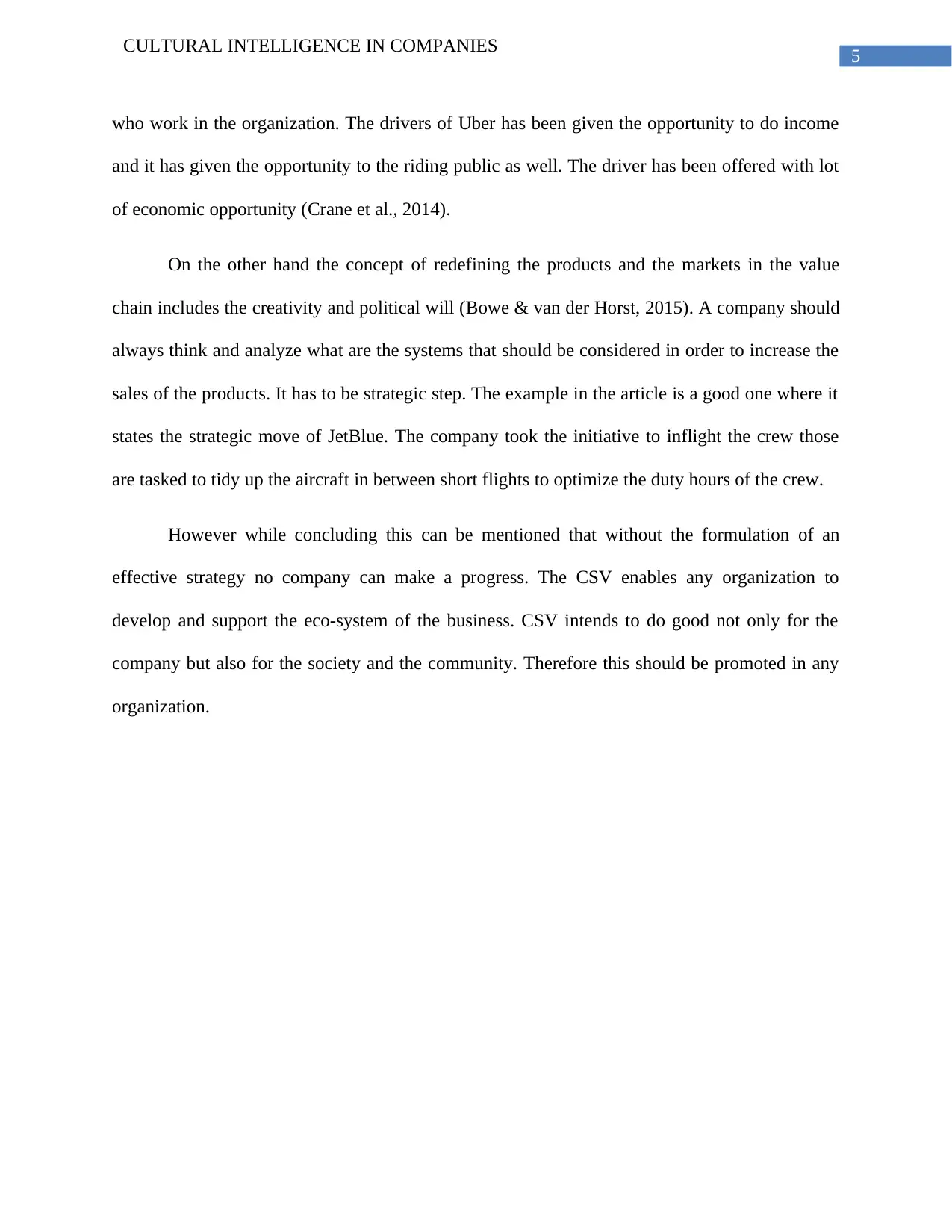
5
CULTURAL INTELLIGENCE IN COMPANIES
who work in the organization. The drivers of Uber has been given the opportunity to do income
and it has given the opportunity to the riding public as well. The driver has been offered with lot
of economic opportunity (Crane et al., 2014).
On the other hand the concept of redefining the products and the markets in the value
chain includes the creativity and political will (Bowe & van der Horst, 2015). A company should
always think and analyze what are the systems that should be considered in order to increase the
sales of the products. It has to be strategic step. The example in the article is a good one where it
states the strategic move of JetBlue. The company took the initiative to inflight the crew those
are tasked to tidy up the aircraft in between short flights to optimize the duty hours of the crew.
However while concluding this can be mentioned that without the formulation of an
effective strategy no company can make a progress. The CSV enables any organization to
develop and support the eco-system of the business. CSV intends to do good not only for the
company but also for the society and the community. Therefore this should be promoted in any
organization.
CULTURAL INTELLIGENCE IN COMPANIES
who work in the organization. The drivers of Uber has been given the opportunity to do income
and it has given the opportunity to the riding public as well. The driver has been offered with lot
of economic opportunity (Crane et al., 2014).
On the other hand the concept of redefining the products and the markets in the value
chain includes the creativity and political will (Bowe & van der Horst, 2015). A company should
always think and analyze what are the systems that should be considered in order to increase the
sales of the products. It has to be strategic step. The example in the article is a good one where it
states the strategic move of JetBlue. The company took the initiative to inflight the crew those
are tasked to tidy up the aircraft in between short flights to optimize the duty hours of the crew.
However while concluding this can be mentioned that without the formulation of an
effective strategy no company can make a progress. The CSV enables any organization to
develop and support the eco-system of the business. CSV intends to do good not only for the
company but also for the society and the community. Therefore this should be promoted in any
organization.
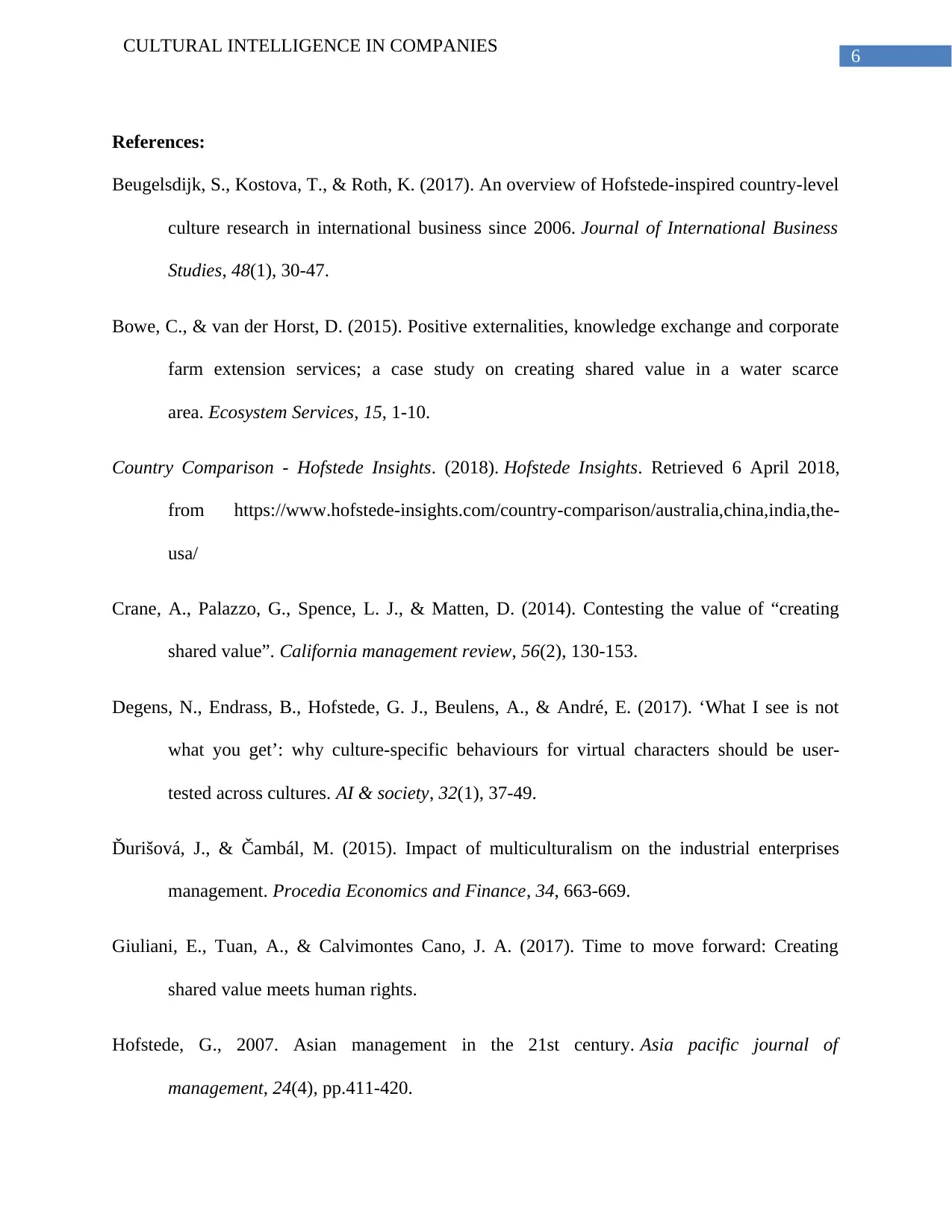
6
CULTURAL INTELLIGENCE IN COMPANIES
References:
Beugelsdijk, S., Kostova, T., & Roth, K. (2017). An overview of Hofstede-inspired country-level
culture research in international business since 2006. Journal of International Business
Studies, 48(1), 30-47.
Bowe, C., & van der Horst, D. (2015). Positive externalities, knowledge exchange and corporate
farm extension services; a case study on creating shared value in a water scarce
area. Ecosystem Services, 15, 1-10.
Country Comparison - Hofstede Insights. (2018). Hofstede Insights. Retrieved 6 April 2018,
from https://www.hofstede-insights.com/country-comparison/australia,china,india,the-
usa/
Crane, A., Palazzo, G., Spence, L. J., & Matten, D. (2014). Contesting the value of “creating
shared value”. California management review, 56(2), 130-153.
Degens, N., Endrass, B., Hofstede, G. J., Beulens, A., & André, E. (2017). ‘What I see is not
what you get’: why culture-specific behaviours for virtual characters should be user-
tested across cultures. AI & society, 32(1), 37-49.
Ďurišová, J., & Čambál, M. (2015). Impact of multiculturalism on the industrial enterprises
management. Procedia Economics and Finance, 34, 663-669.
Giuliani, E., Tuan, A., & Calvimontes Cano, J. A. (2017). Time to move forward: Creating
shared value meets human rights.
Hofstede, G., 2007. Asian management in the 21st century. Asia pacific journal of
management, 24(4), pp.411-420.
CULTURAL INTELLIGENCE IN COMPANIES
References:
Beugelsdijk, S., Kostova, T., & Roth, K. (2017). An overview of Hofstede-inspired country-level
culture research in international business since 2006. Journal of International Business
Studies, 48(1), 30-47.
Bowe, C., & van der Horst, D. (2015). Positive externalities, knowledge exchange and corporate
farm extension services; a case study on creating shared value in a water scarce
area. Ecosystem Services, 15, 1-10.
Country Comparison - Hofstede Insights. (2018). Hofstede Insights. Retrieved 6 April 2018,
from https://www.hofstede-insights.com/country-comparison/australia,china,india,the-
usa/
Crane, A., Palazzo, G., Spence, L. J., & Matten, D. (2014). Contesting the value of “creating
shared value”. California management review, 56(2), 130-153.
Degens, N., Endrass, B., Hofstede, G. J., Beulens, A., & André, E. (2017). ‘What I see is not
what you get’: why culture-specific behaviours for virtual characters should be user-
tested across cultures. AI & society, 32(1), 37-49.
Ďurišová, J., & Čambál, M. (2015). Impact of multiculturalism on the industrial enterprises
management. Procedia Economics and Finance, 34, 663-669.
Giuliani, E., Tuan, A., & Calvimontes Cano, J. A. (2017). Time to move forward: Creating
shared value meets human rights.
Hofstede, G., 2007. Asian management in the 21st century. Asia pacific journal of
management, 24(4), pp.411-420.
Paraphrase This Document
Need a fresh take? Get an instant paraphrase of this document with our AI Paraphraser
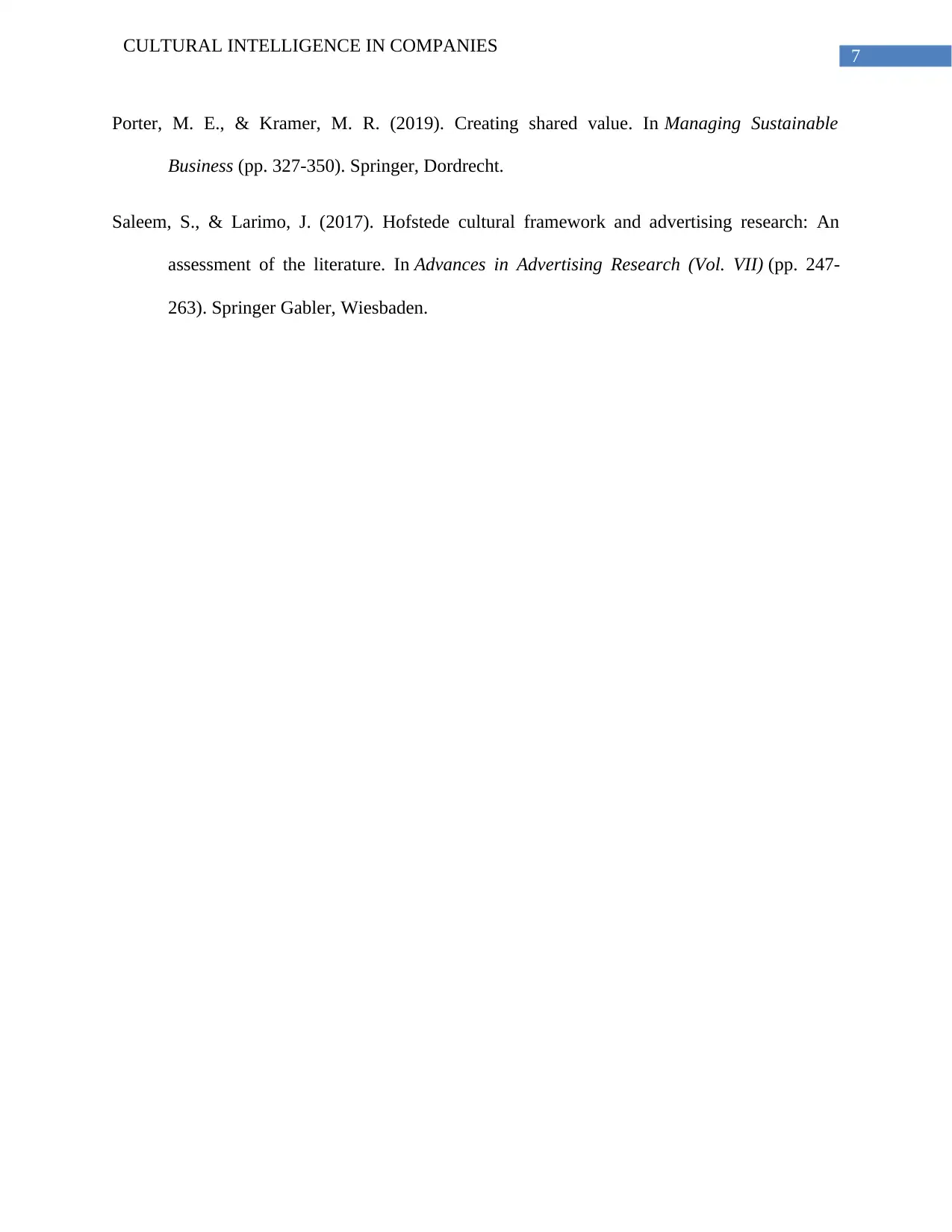
7
CULTURAL INTELLIGENCE IN COMPANIES
Porter, M. E., & Kramer, M. R. (2019). Creating shared value. In Managing Sustainable
Business (pp. 327-350). Springer, Dordrecht.
Saleem, S., & Larimo, J. (2017). Hofstede cultural framework and advertising research: An
assessment of the literature. In Advances in Advertising Research (Vol. VII) (pp. 247-
263). Springer Gabler, Wiesbaden.
CULTURAL INTELLIGENCE IN COMPANIES
Porter, M. E., & Kramer, M. R. (2019). Creating shared value. In Managing Sustainable
Business (pp. 327-350). Springer, Dordrecht.
Saleem, S., & Larimo, J. (2017). Hofstede cultural framework and advertising research: An
assessment of the literature. In Advances in Advertising Research (Vol. VII) (pp. 247-
263). Springer Gabler, Wiesbaden.
1 out of 8
Related Documents
Your All-in-One AI-Powered Toolkit for Academic Success.
+13062052269
info@desklib.com
Available 24*7 on WhatsApp / Email
![[object Object]](/_next/static/media/star-bottom.7253800d.svg)
Unlock your academic potential
© 2024 | Zucol Services PVT LTD | All rights reserved.




